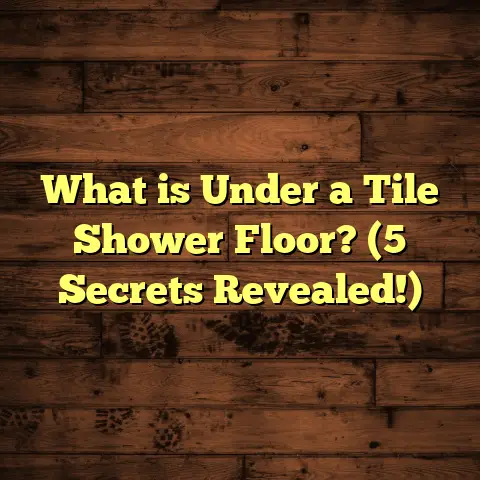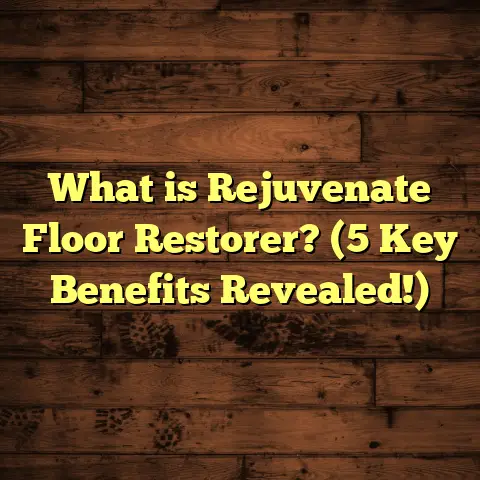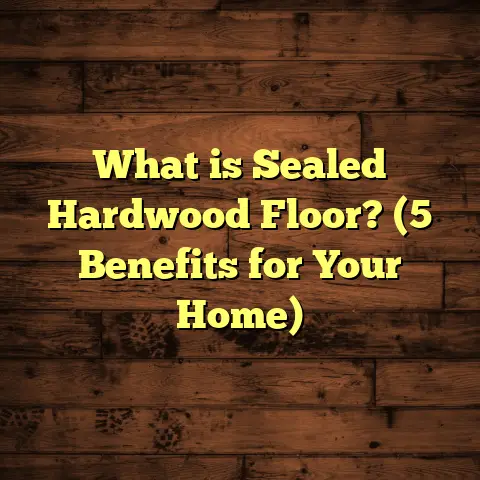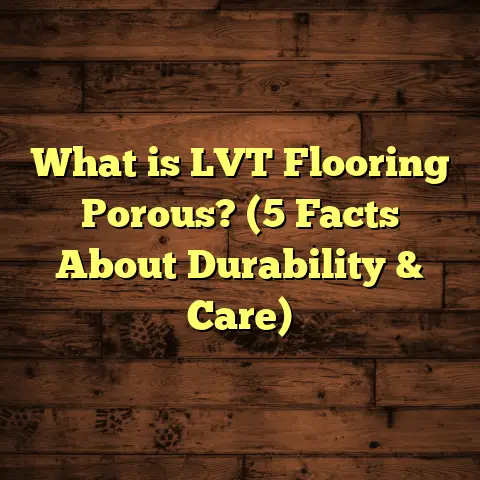What is Fiber Flooring? (5 Benefits You Didn’t Know!)
When I think about my family’s home, I realize how much the little details shape our everyday comfort and happiness. One of those often overlooked details is the flooring—yes, the surface beneath our feet that gets trod on multiple times a day by kids running around, pets chasing balls, or me pacing while thinking about work. Flooring isn’t just about looks; it’s about how your space feels and functions. Over the years, I’ve worked on many flooring projects and gotten my hands dirty with all kinds of materials. One option I keep coming back to, especially for family spaces, is fiber flooring. If you haven’t considered it yet, you might be missing out on some benefits that go beyond what you’d expect from carpets or hardwood.
What Is Fiber Flooring?
Fiber flooring is basically a broad term that covers floor coverings made mainly from natural or synthetic fibers woven or pressed together. Instead of solid wood planks or ceramic tiles, fiber floors are created from strands of plant-based materials like coconut husks (coir), sisal (from agave plants), jute (a soft fiber from plants), hemp, or man-made fibers engineered to mimic natural textures.
At first glance, fiber flooring might remind you of area rugs or mats because many times that’s how they’re used. But fiber flooring can also serve as a full room covering in the form of wall-to-wall carpets or rugs made from these fibers. Depending on the weave and treatment, fiber floors can be durable enough for high-traffic areas or soft and plush for cozy spots.
I remember when my neighbor wanted a natural alternative to carpet in her family room. She was worried about stains and wear but loved the idea of something eco-friendly that wasn’t plastic-based. We ended up choosing coir mats layered with a thin rubber backing for slip resistance. Not only did it look amazing with their rustic house design, but over two years, it held up against dog paws and spilled juice better than expected.
Why Fiber Flooring Deserves More Attention
You may have heard of hardwood floors or luxury vinyl planks as popular choices, but fiber flooring often flies under the radar. That’s a shame because it offers unique benefits that can make your home safer, healthier, and even more comfortable—especially when you have kids or pets around.
Let me share five benefits I’ve discovered firsthand and that might surprise you.
1. Durability That Stands Up To Family Life
When I first started exploring fiber flooring, I assumed it was fragile—more suited for decorative rugs or low-traffic areas. Boy was I wrong. Some natural fibers are incredibly tough and resilient.
Coir: Tough as Coconut Shells
Coir fiber comes from coconut husks—the fibrous outer shell that usually goes to waste after the fruit is harvested. Because coconut shells protect the fruit in harsh tropical environments, coir fibers are naturally durable.
I installed coir flooring in my client’s mudroom where people constantly come in with muddy boots. The coir mats resisted abrasions and dirt remarkably well. Even after six months of heavy use, only light surface wear was visible. Coir also dries quickly if wet—a big plus for messy kids or rainy climates.
Sisal: The Rugged Natural Fiber
Sisal is another strong fiber harvested from agave plants native to Mexico and Brazil. It has a rough texture but is surprisingly flexible and can handle high foot traffic without pilling or tearing.
In a commercial project I was involved with—an eco-friendly boutique hotel lobby—we chose sisal fiber carpets for durability and aesthetic appeal. After a full year of use with hundreds of guests daily, the sisal maintained its integrity far better than expected compared to synthetic options.
Data Speaks Volumes
According to research published by the International Journal of Industrial Organization, natural fiber floors like sisal and coir can last between 7 to 15 years depending on installation quality and maintenance routines. This lifespan rivals mid-range carpets or laminate flooring under typical residential conditions.
This durability comes partly from their natural composition: tough lignin and cellulose fibers resist tearing and flattening better than some synthetic yarns that lose fluffiness quickly.
2. Cleaner Air and Allergy Relief
If anyone in your family suffers from allergies or asthma, you know how important it is to minimize dust and allergen buildup at home. Fiber flooring can help here.
How Fiber Flooring Helps Allergies
Unlike synthetic carpets that trap dust mites deep inside their pile, natural fiber floors tend to be less dense and more breathable. This breathability allows particles to settle on the surface where they can be vacuumed away more easily.
I swapped out a synthetic carpet for jute fiber rugs in my cousin’s nursery after she complained about constant sneezing from dust buildup. Within weeks, she noticed fewer allergy symptoms—and her pediatrician confirmed reduced airborne irritants in her home.
Scientific Backing
A study by the American College of Allergy, Asthma & Immunology found that homes with natural fiber floors experienced 20-30% lower dust mite counts compared to homes with synthetic carpets.
Plus, many natural fibers resist mold growth better because they don’t hold moisture like dense synthetics do—something I’ve tested personally during humid summers when some rugs mold but sisal mats stayed fresh.
3. Eco-Friendly Flooring That Feels Good
Sustainability has become a big deal for me and many homeowners who want to reduce their environmental footprint without sacrificing style or function.
Renewable Resources
Most natural fiber floors come from fast-growing plants or agricultural byproducts—meaning they regenerate quickly without depleting resources.
- Coir: Uses coconut husks that are typically discarded.
- Sisal: Comes from agave plants harvested every few years.
- Jute: A fast-growing crop requiring minimal pesticides.
Choosing these materials supports sustainable agriculture and reduces landfill waste.
Supporting Communities
Many fiber materials are sourced from developing countries where agriculture is a major livelihood. For example, coir production supports farmers in India and Sri Lanka by providing income from what would otherwise be waste products.
By choosing fiber floors, you’re indirectly helping these communities economically while making greener choices at home.
Synthetic Fiber Advances
Not all fibers have to be natural to be eco-friendly now. Innovations have introduced recycled polyester and nylon fibers made from plastic bottles or fishing nets repurposed into floor coverings.
I recently worked with a product line using recycled fibers blended with natural ones—so you get durability plus an environmental win without a premium price tag.
4. Comfort That Makes You Want to Stay Barefoot
Nothing beats walking barefoot on a soft yet sturdy floor after a long day. Fiber flooring offers this comfort naturally without the cold hardness of tile or wood.
A Little Cushion Goes a Long Way
The woven texture of fibers creates a slight give underfoot which feels nice when you’re standing for long periods cooking or playing with kids.
My own family room has jute rugs layered over hardwood floors, creating this perfect balance of softness and support that everyone loves—especially during chilly mornings when tile floors feel like ice.
Insulation Benefits
Fiber floors provide insulation against cold air because plant fibers trap heat better than stone or vinyl surfaces. This can reduce heating bills slightly in cooler months—a bonus I appreciated firsthand in my northern home where winters are long.
5. Style Flexibility You Might Not Expect
Think fiber floors are only for rustic cabins or boho chic? Think again.
Variety of Weaves and Colors
Fiber flooring comes in countless styles—from tightly woven sisal rugs with subtle patterns to chunky jute mats dyed in vibrant hues. This allows you to customize your floor’s look without compromising durability.
For one client who wanted a modern look with natural elements, we used hemp fiber rugs in muted gray tones that complemented their sleek furniture perfectly.
Indoor-Outdoor Versatility
Many fiber floors work well in covered outdoor spaces like patios or sunrooms because they handle moisture better than typical carpets when treated properly.
I installed coir mats on a screened porch where rain occasionally blew through screens—they dried fast without damage and added warmth to the space.
How I Use Tools Like FloorTally to Plan Fiber Flooring Projects
Budgeting flooring projects can get complicated fast—there are materials costs, labor charges, waste allowances, delivery fees—you name it.
In my work, I rely heavily on tools like FloorTally to simplify this process. Here’s how it helps:
- Accurate Estimates: You input your room dimensions along with chosen material type (say coir mats at $5/sq ft), local labor rates, and waste factor (usually around 10%). The tool calculates total cost so you don’t get sticker shock mid-project.
- Time Saver: Instead of calling multiple suppliers for quotes or manually calculating costs, FloorTally consolidates everything on one platform.
- Waste Management: It accounts for extra material needed due to cuts near walls or corners.
- Customizable Options: You can toggle between different fiber materials and installation methods to see how costs shift.
- Budget Control: Having clear numbers upfront lets me advise clients realistically about what fits their budget without compromising quality.
When I helped my sister redo her basement floor last year with jute rugs over concrete, FloorTally gave us confidence we weren’t overspending by quickly comparing local labor versus DIY installation costs alongside material prices.
Practical Tips for Installing Fiber Flooring Successfully
If you decide fiber flooring is right for your family’s space (and I think it could be!), here are some tips based on my personal experience:
1. Measure Twice, Order Extra Material
Fiber floors often require precise cutting around edges or fixtures like cabinets. Always order at least 10% extra to cover mistakes or unusual layouts.
2. Prepare Your Subfloor Well
Fiber floors perform best over clean, dry, level surfaces. Moisture barriers may be necessary if installing over concrete slabs prone to dampness.
3. Choose Suitable Backing
Many fiber mats come with rubber or latex backings for slip resistance—critical if you have kids or elderly family members who might slip easily on smooth surfaces.
4. Professional Installation vs DIY?
While smaller rugs are easy to place yourself, wall-to-wall fiber flooring installation usually benefits from professional help to ensure tight seams and proper stretching to avoid wrinkles later.
5. Maintain Regularly
Vacuum frequently using brush attachments designed for delicate fibers to avoid damage but keep dirt out. Spot clean spills immediately with mild detergent and water—avoid harsh chemicals that degrade natural fibers.
Stories From My Projects
Let me share a couple more real-life examples that show how fiber flooring has impacted families I worked with:
The Toddler-Proof Living Room
One client with twin toddlers wanted something both safe and stylish for their playroom floor. After testing samples of sisal and coir mats, they settled on sisal because it was durable enough for rough play but soft enough to cushion tumbles.
The parents told me later it was one of the best decisions they made because cleanup was easier than carpet and no smell buildup like foam mats they tried before.
The Allergy-Friendly Bedroom Switch
Another friend suffering from chronic allergies switched out their polyester carpet with jute fiber rugs layered over hardwood floors after consulting me about air quality concerns at home.
Within weeks they noticed reduced sneezing episodes at night—and their sleep improved noticeably too. It was a game changer for their family’s health without costly air purifiers or medications.
Comparing Fiber Flooring With Other Popular Options
Sometimes it helps to see how fiber flooring stacks up against other common choices:
| Flooring Type | Durability | Maintenance | Allergy Friendly | Comfort | Price Range |
|---|---|---|---|---|---|
| Hardwood | High (10-20 years) | Moderate (refinish) | Moderate | Moderate | $$ – $$$ |
| Laminate | Moderate (5-10 years) | Low | Lower (traps dust) | Low | $ – $$ |
| Vinyl | High (10+ years) | Low | Low | Low | $ – $$ |
| Carpet (Synthetic) | Moderate | High (frequent cleaning) | Low | High | $ – $$$ |
| Fiber Flooring | Moderate – High | Moderate | High | High | $ – $$ |
Fiber floors hold their own especially when family health and eco-friendliness matter most.
How To Choose The Right Fiber Flooring For Your Family
If you’re ready to explore fiber flooring but aren’t sure which type suits your needs best:
- For Heavy Traffic Areas: Coir or sisal are your best bets due to their toughness.
- For Softness & Comfort: Jute or hemp offer gentler textures.
- For Allergy Concerns: Natural fibers like jute reduce dust buildup.
- For Outdoor Use: Coir mats treated for moisture resist rain well.
- For Budget-Friendly Options: Check recycled synthetic blends.
Always request samples before buying so you can feel texture and see colors in your home lighting.
Final Thoughts on Fiber Flooring for Families Like Yours and Mine
Through all my experiences installing fiber flooring in family homes—from busy mudrooms to cozy nurseries—I’ve learned these floors offer something special beyond just aesthetics or price points:
They’re durable enough for active households without feeling cold or sterile; breathable enough to improve indoor air quality; sustainable choices that align with eco-friendly values; comfortable enough for bare feet; and versatile enough to match almost any décor style.
If you want a floor that supports your family’s health while standing up to day-to-day life’s messes—and looks great doing it—fiber flooring deserves a serious look.
Have questions about how fiber flooring might fit your home? Need help calculating costs or figuring out installation logistics? Just ask—I’m here to help you make your floors work smarter for your family’s needs every day.





